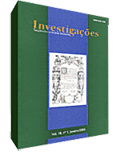Notas sobre o diálogo no teatro contemporâneo: uma análise de Dans la Solitude des Champs de Coton, de Bernard-Marie Koltès
Abstract
O presente trabalho faz parte de uma pesquisa mais ampla sobre a construção discursiva no teatro contemporâneo brasileiro e francês. Nosso objetivo maior, neste primeiro momento, é analisar a estrutura complexa do diálogo na peça Dans La Solitude des Champs de Coton, do dramaturgo francês Bernard-Marie Koltès, com a finalidade de caracterizar a relação que se estabelece, pelo texto dramático contemporâneo, entre autor-público. O teatro contemporâneo se particulariza pela relação difícil, tortuosa entre texto e leitor. Veremos que o leitor precisa assumir uma postura ativa diante da peça e seguir algumas pistas colocadas no texto pelo autor, a fim de poder interagir com o objeto estético.References
ABIRACHED, Robert. 1994. La crise du personnage dans le théâtre
moderne. Paris: Galimard.
FISCHER-LICHTE, Erika. Written Drama — Oral Performance. In:
Quasthoff, U.M. 1995. Aspects of oral communication. Berlim: Walter
de Gruyter, pp. 305-321.
GOFFMAN, Erwin. 1974. Les rites d’interaction. Paris: Seuil.
GRICE, Paul. Lógica e Conversação. Trad. João Wanderley Geraldi.
In: Dascal, M.(org.). 1982. Fundamentos metodológicos da lingüística.
Pragmática. Campinas: Editora do autor, vol. IV.
KOLTÈS, Bernard-Marie. 1986. Dans la solitude des champs de coton.
Paris: Les Éditions de Minuit.
______. 1991. Prologue. Paris: Les Éditions de Minuit.
RYNGAERT, Jean-Pierre. 1998. Ler o teatro contemporâneo. São Paulo: Martins Fontes.
SZONDI, Peter. Teoria do drama moderno [1880-1950]. 2001. São Paulo: Cosac e Naify.
UBERSFELD, A. 1996. Lire le thêatre: le dialogue de thèâtre. Paris:
Belin, V.3.
Downloads
Published
How to Cite
Issue
Section
License
Copyright (c) 2005 Elton Bruno Soares de Siqueira

This work is licensed under a Creative Commons Attribution 4.0 International License.
Authors who publish with Revista Investigações agree to the following terms:
Authors retain copyright and grant the journal right of first publication with the work simultaneously licensed under the Creative Commons Attribution 4.0 International (CC BY 4.0) license that allows others to share the work with an acknowledgement of the work's authorship and initial publication in this journal.
Authors are able to enter into separate, additional contractual arrangements for the non-exclusive distribution of the journal's published version of the work (e.g., post it to an institutional repository or publish it in a book), with an acknowledgement of its initial publication in this journal.
You are free to:
Share — copy and redistribute the material in any medium or format for any purpose, even commercially.
Adapt — remix, transform, and build upon the material for any purpose, even commercially.
The licensor cannot revoke these freedoms as long as you follow the license terms.
Under the following terms:
Attribution — You must give appropriate credit , provide a link to the license, and indicate if changes were made . You may do so in any reasonable manner, but not in any way that suggests the licensor endorses you or your use.
No additional restrictions — You may not apply legal terms or technological measures that legally restrict others from doing anything the license permits.

